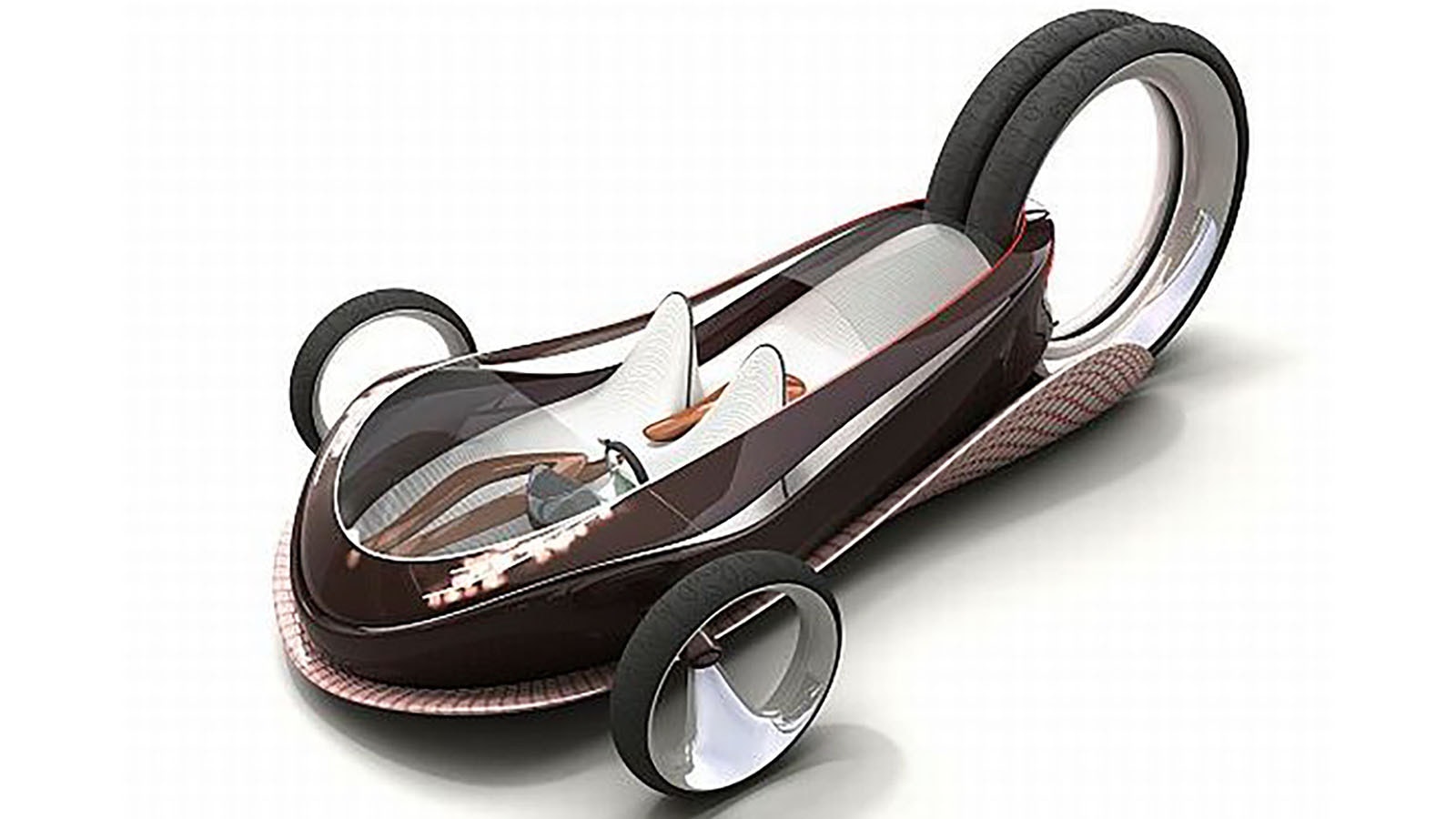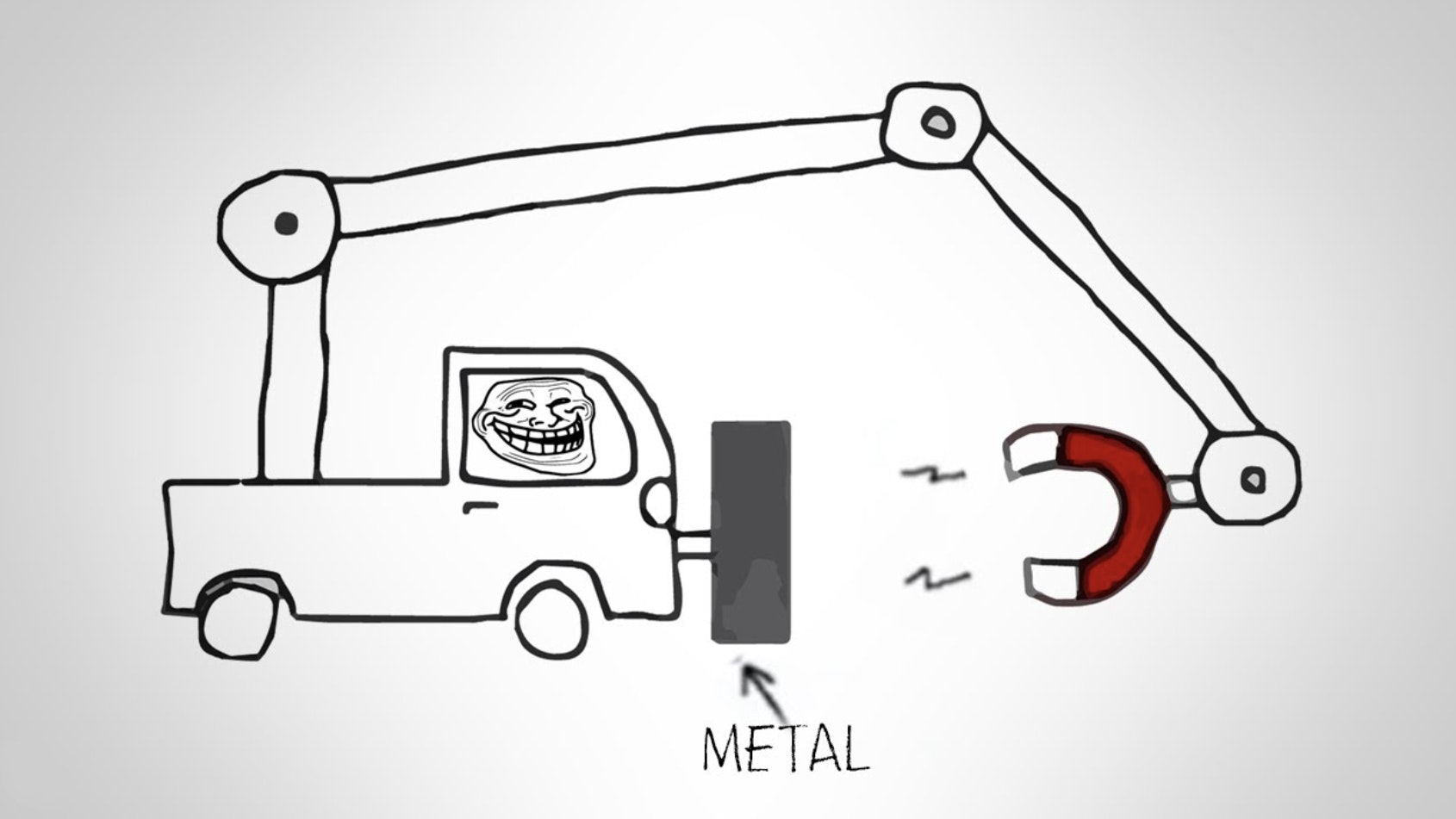Could a magnet-propelled car actually work?
That’s the proposition behind a popular meme circulating in the webosphere. Various cartoon variations show a car or truck with a giant magnet attached to the grill and another giant magnet facing toward the vehicle being suspended by a crane arm of some kind.
Opposites attract when it comes to the type of polarization of magnets, so could perpetual motion be achieved? Why aren’t we all driving magnet cars?
Hint: The answer has nothing to do with the powerful lobbying influence of giant oil companies.
Deep down, we all inherently know it simply can’t be possible to create a self-propelled car by using magnetic force.
There’s something that doesn’t quite look right about the artwork in the meme. There is probably some science-y thing at play here. And, finally, if it could work, Big Oil would be bankrupt and you wouldn’t be pumping $3.89-a-gallon’s worth of their product into your gas-guzzler every three days.
More than a few memes and YouTube videos explore the idea, many conveying essentially the same thing. If a magnet was somehow suspended directly in front of a car or truck, and another magnet (or even a slab of metal) was affixed to the vehicle’s grill, wouldn’t the vehicle be either pulled or repelled against the suspended magnet, thus moving the vehicle down the road?
And with a flip of a switch, magnets could also be reversed to create like poles that repel one another, which can push a vehicle forward or backward, depending on which like poles are facing each other.
About Magnets
Before the debunking begins, a few basic facts about magnets are important to remember.
Magnets are made of ferromagnetic metals. Nickel and iron are prime examples of these metals. The strongest magnets in the world are composed of rare-earth metals like samarium cobalt and neodymium magnets.
Every magnet has two poles of opposite polarity. For convention’s sake they are referred to as north and south poles, but that is not technically correct, nor is it important to delve into the weeds of why not.
Suffice to say, anyone who has played with magnets knows that opposite poles seek each other with force, and like poles of two magnets repel one another.
Magnets love iron especially. It is one of the earth’s most abundant metals. When exposed to a magnetic field, iron atoms begin to align their electrons with the flow of the magnetic field, which makes the iron magnetized as well.
When the electrons of the two objects are all spinning in the same direction, well, this is what creates an attraction between the two magnetized objects.
By the way, magnets weaken over time — though very slowly — like a 2% loss over 100 years. Magnetism is also affected by temperature: Cold makes them stronger, heat weakens their properties.
Design Flaw
Back to the meme. Assuming magnets are aligned with opposite poles facing each other, would not the magnetic field created in front of a vehicle cause it to forever chase the magnet dangled ahead like a mule to a carrot?
No, it will not. Here’s why.
Turns out, Isaac Newton was a pretty smart dude. All that sitting around underneath apple trees gave him a lot of time to come up ingenious laws like: “An object at rest will remain at rest unless acted upon by an outside force.”
Newton’s first law, that of inertia, goes a long way to explaining why or how a vehicle could be caused to move in our case of the lodestone lorry. While a magnet dangled beckoningly out ahead of a car or truck may seem like an outside or external force, it is not.
Since both magnets are connected to the same frame and, therefore, are part of a single system, there is no external force at work. Both magnets, or even a magnet and a block of iron, are creating a net zero force as they pull at one another, cancelling each other out. Zero net force means zero acceleration.
How do we know this? Newton’s Third Law of Physics: For every action (force) in nature there is an equal and opposite reaction.
The physics become clear, and the meme laughable, when applied to, say, Baron Munchausen’s wild claim of pulling himself out of a swamp by his own hair. It just doesn’t work any better than pushing on your steering wheel will make your Toyota drive faster.
By the way, don’t be fooled by another popular piece of internet lore out there. Two such viral videos posted by veproject1 in 2012 and 2014 chronicle an experiment showing a toy car actually zooming across a tabletop surface when magnets are employed ala aforementioned meme. They are fake.

Cartoon Clever
Even a bumbling cartoon figure created by Looney Tunes knows how magnets work.
Wile E. Coyote has never been accused of being the sharpest tool in the shed. Over and over again, the dimwitted coyote comes up with one screwball plan after another, only to be foiled by the smarter, faster Road Runner.
Persistent, yes — and without doubt ACME’s best customer.
But in one particular episode, Wile E. exhibits a basic understand of physics and how magnets work. He hatches a plan to catch the roadrunner by putting out bird seed laced with extra iron. Meanwhile, the crafty coyote attaches a gigantic magnet to himself while on roller skates.
No matter how fast that “beep beep” bird is, Wile E. will get dragged along right behind him, right? Theoretically, yes.
Forgetting for a moment that it would take an awful lot of iron to overcome the effects of friction, the cartoon coyote at least has two of Newton’s laws well-reasoned. As his magnet pulls on the roadrunner, the iron in Road Runner’s stomach pulls back at the magnet.
Since the two forces don't cancel each other out, Wile E. can and does race behind the fleet-footed fowl until a larger, stronger attractant is added to the scene and the coyote is flattened by a train.
Bullet Trains Use Magnets
Don’t be too quick to dismiss the idea that magnets can be used to create propulsion. They can, and they are being used in the real world today.
In places like Japan and China, magnets are used in the world’s fastest trains, for instance.
The Maglev is a superconducting magnetic train capable of speeds in excess of 600 kph. The word maglev is a combination of the words magnetic and levitation. This new age type of train was developed by the Central Japan Railway Co. and the Railway Technical Research Institute beginning in the 1970s.
In April 2015, a manned superconducting Maglev train set the record for rail vehicles. The train was clocked at 603 kph, or 375 mph.
Such trains are in use today in Shanghai, China, where they average around 300 mph.
Japan hopes its magnetic bullet train, the Chuo Shinkansen, will connect Tokyo and Osaka in one hour by 2045. Talks are underway to bring a similar line to the U.S., linking New York and Washington, D.C.
By design, maglev trains float over guideways using the basic principle behind electromagnetic propulsion to replace the old steel wheel and track trains. Without rail friction, these trains can achieve high speeds with virtually no wear-and-tear.
To date, the system has its drawbacks. It is expensive to build, maintain and power. An enormous amount of electricity is used to create a powerful magnetic field between track and train.
Scientists in China last year announced they had made a major breakthrough in maglev train technology. Last August, China launched the Red Rail, a “sky train” built with permanent magnets that can keep a train afloat with no power supply.
Musk Et Al
Elon Musk’s The Boring Co. (TBC) continues to plug away at a full-scale high-speed Hyperloop transportation system even after setbacks last year when city officials in Hawthorne, California, pulled the plug on a tunnel project.
Musk whiteboarded the concept a decade ago, but after burning through a reported billion dollars, has little to show for it. TBC continues work on the Vegas Loop — a 65-mile car tunnel network underneath Las Vegas that will boast 69 stations at buildout.
Rumors are Musk’s TBC is shifting Hyperloop to Texas, where it could one day link Dallas to Austin to San Antonio.
Not to be outdone by the private sector, the Pentagon announced earlier this month it is developing magnetohydrodynamic technology to propel warships and submarines using magnetic fields instead of propellers.
Finally, every year it seems researchers come closer to building the first vehicle driven solely by electromagnetic propulsion technology. Some of them are pretty far out, but the scientific principles are sound.
Jake Nichols can be reached at jake@cowboystatedaily.com.





